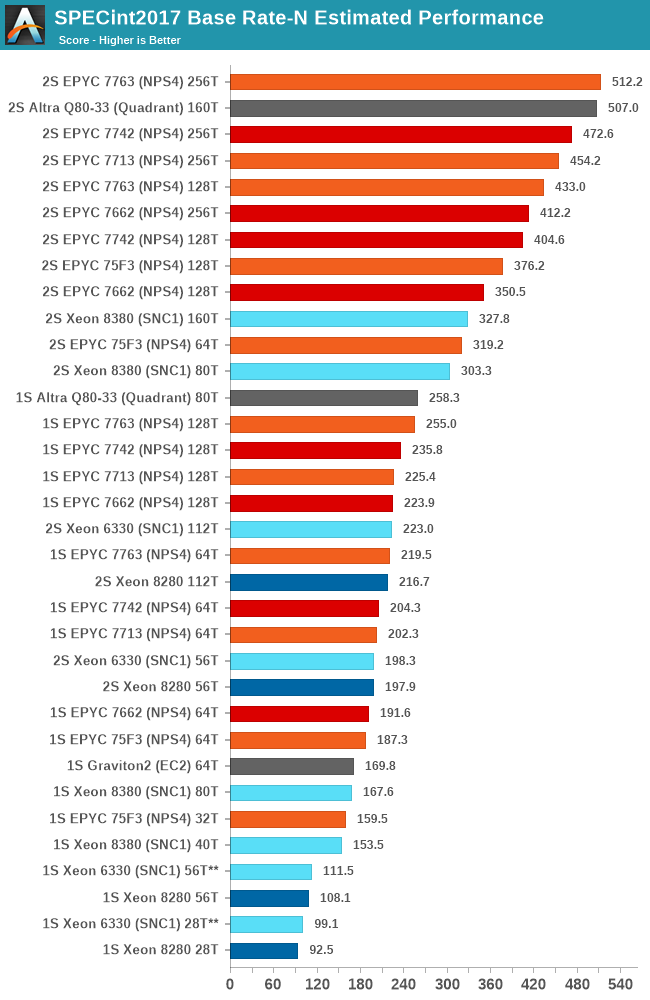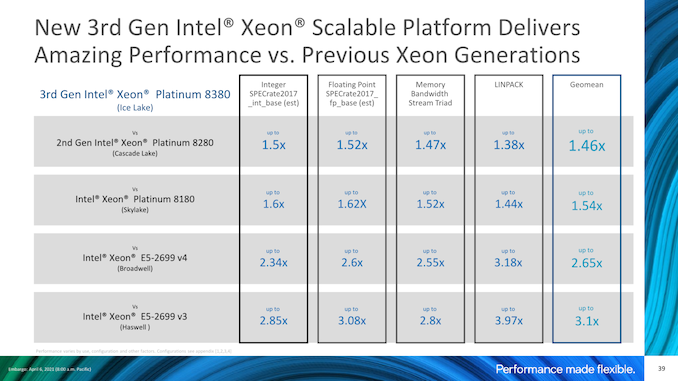Intel 3rd Gen Xeon Scalable (Ice Lake SP) Review: Generationally Big, Competitively Small
by Andrei Frumusanu on April 6, 2021 11:00 AM EST- Posted in
- Servers
- CPUs
- Intel
- Xeon
- Enterprise
- Xeon Scalable
- Ice Lake-SP
SPEC - Multi-Threaded Performance
Picking up from the power efficiency discussion, let’s dive directly into the multi-threaded SPEC results. As usual, because these are not officially submitted scores to SPEC, we’re labelling the results as “estimates” as per the SPEC rules and license.
We compile the binaries with GCC 10.2 on their respective platforms, with simple -Ofast optimisation flags and relevant architecture and machine tuning flags (-march/-mtune=Neoverse-n1 ; -march/-mtune=skylake-avx512 ; -march/-mtune=znver2 (for Zen3 as well due to GCC 10.2 not having znver3).
The new Ice Lake SP parts are using the -march/-mtune=icelake-server target. It’s to be noted that I briefly tested the system with the Skylake binaries, with little differences within margin of error.
I’m limiting the detailed comparison data to the flagship SKUs, to indicate peak performance of each platform. For that reason it’s not exactly as much an architectural comparison as it’s more of a top SKU comparison.

To not large surprise, the Xeon 8380 is posting very impressive performance advancements compared to the Xeon 8280, with large increases across the board for all workloads. The geo-mean increase is +54% with a low of +40% up to a high of +71%.
It’s to be noted that while the new Ice Lake system is a major generational boost, it’s nowhere near enough to catch up with the performance of the AMD Milan or Rome, or Ampere’s Altra when it comes to total throughput.

Looking at the FP suite, we have more workloads that are purely memory performance bound, and the Ice Lake Xeon 8380 again is posting significant performance increases compared to its predecessor, with a geo-mean of +53% with a range of +41% to +64%.
In some of the workloads, the new Xeon now catches up and is on par with AMD’s EPYC 7763 due to the fact that both systems have the same memory configuration with 8-channel DDR4-3200.
In any other workloads that requires more CPU compute power, the Xeon doesn’t hold up nearly as well, falling behind the competition by significant margins.

In the aggregate geomean scores, we’re seeing again that the new Xeon 8380 allows Intel to significantly reposition itself in the performance charts. Unfortunately, this is only enough to match the lower core count SKUs from the competition, as AMD and Ampere are still well ahead by massive leads – although admittedly the gap isn’t as embarrassing as it was before.

In the floating-point suite, the results are a bit more in favour for the Xeon 8380 compared to the integer suite, as the memory performance is weighed more into the total contribution of the total performance. It’s still not enough to beat the AMD and Ampere parts, but it’s much more competitive than it was before.
The Xeon 6330 is showcasing minor performance improvements over the 8280 and its cheaper equivalent the 6258R, but at least comes at half the cost – so while performance isn’t very impressive, the performance / $ might be more competitive.
Our performance results match Intel’s own marketing materials when it comes to the generational gains, actually even surpassing Intel’s figures by a few percent.
If you would be looking at Intel’s slide above, you could be extremely enthusiastic about Intel’s new generation, as indeed the performance improvements are extremely large compared to a Cascade Lake system.
As impressive as those generational numbers are, they really only help to somewhat narrow the Grand Canyon sized competitive performance gap we’ve had to date, and the 40-core Xeon 8380 still loses out to a 32-core Milan, and from a performance / price comparison, even a premium 75F3 costs 40% less than the Xeon 8380. Lower SKUs in the Ice Lake line-up would probably fare better in perf/$, however would also just lower the performance to an even worse competitive positioning.











169 Comments
View All Comments
TomWomack - Wednesday, April 7, 2021 - link
Is it known whether there will be an IceLake-X this time round? The list of single-Xeon motherboard launches suggests possibly not; it would obviously be appealing to have a 24-core HEDT without paying the Xeon premium.EthiaW - Wednesday, April 7, 2021 - link
Boeings and Airbuses are never actually sold at their nominal prices, they cost far less, a non-disclosed number, for big buyers after gruesome haggling, sometimes less than half the “catalogue” price.I think this is exactly what's intel doing now: set the catalogue price high to avoid losing face, and give huge discount to avoid losing market share.
duploxxx - Wednesday, April 7, 2021 - link
well easy conclusion.EPYC 75F3 is the clear winner SKU and the must have for most of the workloads.
This is based on price - performance - cores and its related 3rd party sw licensing...
I wonder when Intel will be able to convince VMware to move from a 32core licensing schema to a 40core :)
They used to get all the dev favor when PAT was still in the house, I had several senior engineers in escalation calls stating that the hypervisor was optimised for Intel ...guess what even under optimised looking for a VM farm in 2020-2021-....you are way better off with an AMD build.
WaltC - Wednesday, April 7, 2021 - link
If you can't beat the competition, then what? Ian seems to be impressed that Intel was finally able to launch a Xeon that's a little faster than its previous Xeon, but not fast enough to justify the price tag in relation to what AMD has been offering for a while. So here we are congratulating Intel on burning through wads more cash to produce yet-another-non-competitive result. It really seems as if Intel *requires* AMD to set its goals and to tell it where it needs to go--and that is sad. It all began with x86-64 and SDRAM from AMD beating out Itanium and RDRAM years ago. And when you look at what Intel has done since it's just not all that impressive. Well, at least we can dispense with the notion that "Intel's 10nm is TSMC's 7nm" as that clearly is not the case.JayNor - Wednesday, April 7, 2021 - link
What about the networking applications of this new chip? Dan Rodriguez's presentation showed gains of 1.4x to 1.8x for various networking benchmarks. Intel's entry into 5G infrastructure, NFV, vRAN, ORAN, hybrid cloud is growing faster than they originally predicted. They are able to bundle Optane, SmartNICs, FPGAs, eASIC chips, XeonD, P5900 family Atom chips... I don't believe they have a competitor that can provide that level of solution.Bagheera - Thursday, April 8, 2021 - link
Patr!ck Patr!ck Partr!ck?evilpaul666 - Saturday, April 10, 2021 - link
It only works in front of a mirror. Donning a hoodie helps, too.Oxford Guy - Wednesday, April 7, 2021 - link
There is some faulty logic at work in many of the comments, with claims like it's cheating to use a more optimized compiler.It's not cheating unless:
• the compiler produces code that's so much more unstable/buggy that it's quite a bit more untrustworthy than the less-optimized compiler
• you don't make it clear to readers that the compiler may make the architecture look more performant simply because the other architectures may not have had compiler optimizations on the same level
• you use the same compiler for different architectures when using a different compiler for one or more other architectures will produce more optimized code for those architectures as well
• the compiler sabotages the competition, via things like 'genuine Intel'
Fact is that if a CPU can accomplish a certain amount of work in a certain amount of time, using a certain amount of watts under a certain level of cooling — that is the part's actual performance capability.
If that means writing machine code directly (not even assembly) to get to that performance level, so what? That's an entirely different matter, which is how practical/economical/profitable/effortful it is to get enough code to measure all of the different aspects of the part's maximum performance capability. The only time one can really cite that as a deal-breaker is if one has hard data to demonstrate that by the time the hand-tuned/optimized code is written changes to the architecture (and/or support chips/hardware) will obsolete the advantage — making the effort utterly fruitless, beyond intellectual curiosity concerning the part's ability. For instance, if one knows that Intel, for instance, is going to integrate new instructions (very soon) that will make various types of hand-tuned assembly obsolete in short order, it can be argued that it's not worth the effort to write the code. People made this argument with some of AMD's Bulldozer/Piledriver instructions, on the basis that enough industry adoption wasn't going to happen. But, frankly... if you're going to make claims about the part's performance, you really should do what you can to find out what it is.
Oxford Guy - Wednesday, April 7, 2021 - link
One can, though, of course... include a disclaimer that 'it seems clear enough that, regardless of how much hand-tuned code is done, the CPU isn't going to deliver enough to beat the competition, if the competition's code is similarly hand-tuned' — if that's the case. Even if a certain task is tuned to run twice as fast, is it going to be twice as fast as tuned code for the competition's stuff? Is its performance per watt deficit going to be erased? Will its pricing no longer be a drag on its perceived competitiveness?For example, one could have wrung every last drop of performance out of Bulldozer but it wasn't going to beat Sandy Bridge E — a chip with the same number of transistors. Piledriver could beat at least the desktop version of Sandy in certain workloads when clocked well outside of the optimal (for the node's performance per watt) range but that's where it's very helpful to have tests at the same clock. It was discovered, for instance, that the Fury X and Vega had basically identical performance at the same clock. Since desktop Sandy could easily clock at the same 4.0 GHz Piledriver initially shipped with it could be tested at that rate, too.
Ideally, CPU makers would release benchmarks that demonstrate every facet of their chip's maximum performance. The concern about those being best-case and synthetic is less of a problem in that scenario because all aspects of the chip's performance would be tested and published. That makes cherry-picking impossible.
mode_13h - Thursday, April 8, 2021 - link
The faulty logic I see is that you seem to believe it's the review's job to showcase the product in the best possible light. No, that's Intel's job, and you can find plenty of that material at intel.com, if that's what you want.Articles like this should focus on representing the performance of the CPUs as the bulk of readers are likely to experience it. So, even if using some vendor-supplied compiler with trick settings might not fit your definition of "cheating", that doesn't mean it's a service to the readers.
I think it could be appropriate to do that sort of thing, in articles that specifically analyze some narrow aspect of a CPU, for instance to determine the hardware's true capabilities or if it was just over-hyped. But, not in these sort of overall reviews.